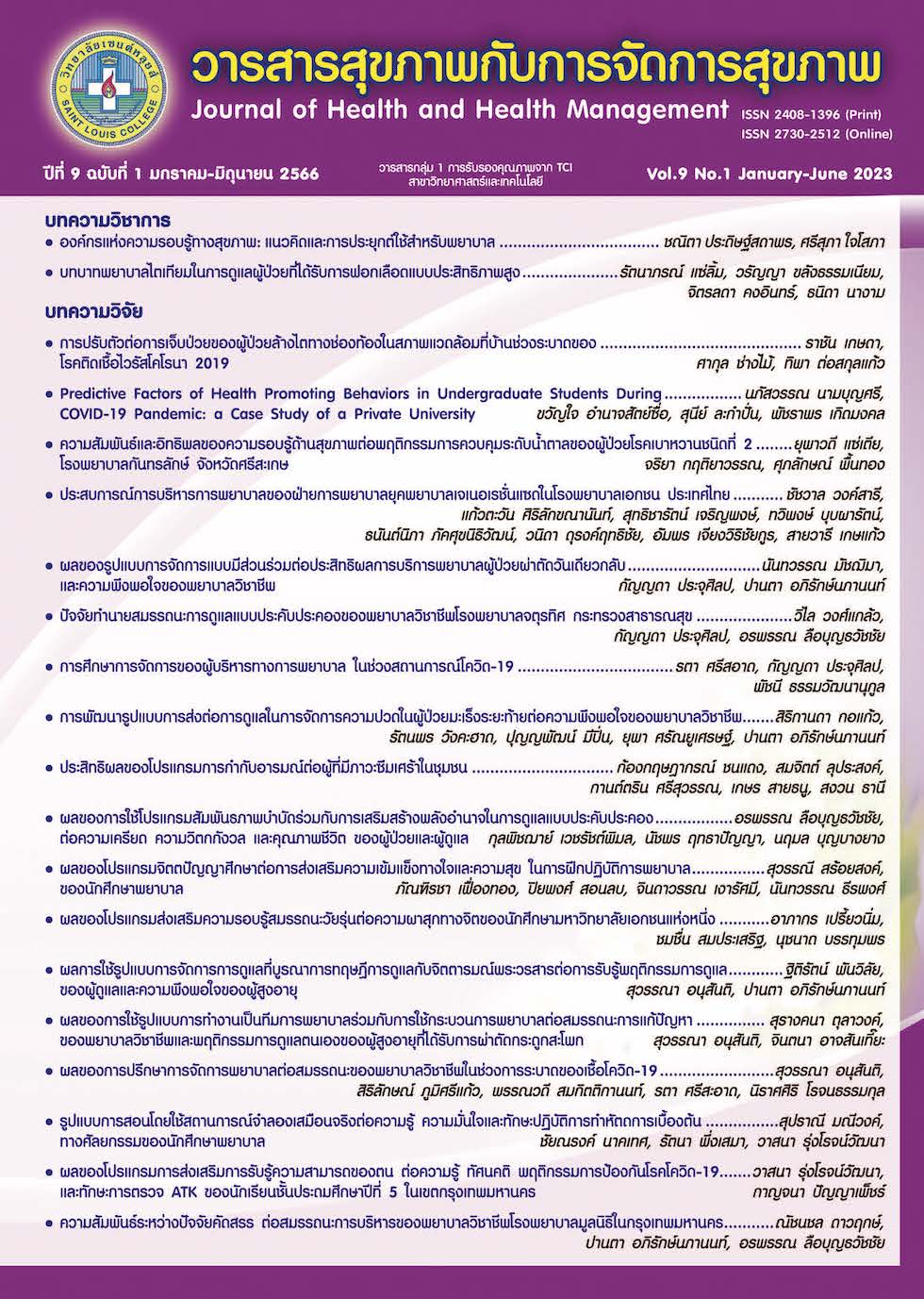Predicting Factors of Palliative Care of Professional Nurses’ Competencies,The Chaturathit Hospitals, The Ministry of Public Health
Keywords:
emotional intelligence, Palliative care of professional nurses’ competencies, work environmentAbstract
This research study aims to 1) investigate the relationship between the ability to provide structured care, emotional intelligence, and work environment, 2) study the relationship between emotional intelligence and work environment with the ability to provide structured care among professional nurses and 3) investigate the factors that can jointly predict the ability to provide structured care among professional nurses in the Chaturathit hospital. The sample group consists of 255 professional nurses who provide structured care at Chaturathit Hospital. The data collection tools include personal information questionnaire, emotional intelligence questionnaire, working environment questionnaire, and the ability to supervise and manage the nursing profession, which have been verified for content by experts and tested for reliability using Cronbach's alpha method, have values of .932, .958, and .980 respectively. And the CVI values are .97, .93 and .95 respectively.The data analysis will be conducted using descriptive statistics, inferential statistics, and multiple regression analysis. The findings of this research will provide useful information for the development of nursing staff's supervision ability and work environment in the Chaturathit Hospital. The intelligence of emotions and working environment (average score = 4.01, 4.10 and 3.97 respectively) have a positive correlation with the ability of nursing staff to provide comprehensive care at Chaturathit Hospital. This correlation is statistically significant (p < .05) with correlation coefficients of .777 and .773 respectively. The factors that can predict the ability of nursing staff to provide comprehensive care at Chaturathit Hospital are intelligence of emotions and working environment (p < .05) with a prediction power of 68.50% (R2 = .685) This research is a guide in evaluating the performance of professional nurses in a controlled environment. It aims to motivate professional nurses to develop themselves, improve their communication skills, understanding of themselves and others, and increase their ability to manage themselves and create harmony with others. This will lead to a more effective performance in their work.
References
กรมสุขภาพจิต. (2550). รายงานวิจัยการพัฒนาแบบประเมินความฉลาด ทางอารมณ์ สำหรับประชาชนไทย อายุ 12 ถึง 60 ปี. กรุงเทพ: สำนักพิมพ์วงศ์กมลโปรดักชั่น.
กลุ่มงานพัฒนาระบบบริการสุขภาพ. (2562). สำเนาคำสั่งแต่งตั้งคณะกรรมการพัฒนาโรงพยาบาลจตุรทิศ. สืบค้นจาก https://phdb.moph.go.th/main/index/detail/30058
ฉันทนา หมอกเจริญพงศ์. (2563). Pandemic palliative care: Beyond ventilators and saving lives (ตอนที่ 1). วารสารเวชบำบัดวิกฤติ, 28(1), 14-16.
ชุติกาญจน์ หฤทัย, อัมราภัสร์ อรรถชัยวัจน์, และโศภิษฐ์ สุวรรณเกศาวงษ์. (2559). ระบบบริการพยาบาลแบบประคับประคอง. กรุงเทพฯ: สื่อตะวัน.
ดาราวรรณ รองเมือง, ฉันทนา นาคฉัตรีย์, และเพ็ญศรี ทองเพชร. (2561). สมรรถนะในการดูแลผู้ป่วยระยะสุดท้ายแบบประคับประคองของพยาบาลวิชาชีพในเขตสุขภาพที่ 11. วารสารพยาบาลทหารบก, 19(ฉบับพิเศษ), 412-422.
นฤมล ศิลวิศาล. (2560). ความสัมพันธ์ระหว่างประสบการณ์การปฏิบัติงาน การอบรมเฉพาะทาง ความฉลาดทางอารมณ์ สภาพแวดล้อมในการทำงาน กับสมรรถนะพยาบาลวิชาชีพในหอผู้ป่วยวิกฤตศัลยศาสตร์หัวใจและทรวงอก โรงพยาบาลระดับตติยภูมิ กรุงเทพมหานคร. (วิทยานิพนธ์ปริญญามหาบัณฑิต). จุฬาลงกรณ์มหาวิทยาลัย, กรุงเทพฯ.
นิตยา ทรัพย์วงศ์เจริญ, และทีปทัศน์ ชินตาปัญญากุล. (2563). บทบาทพยาบาลในการดูแลแบบประคับประคอง ในโรงพยาบาลระดับตติยภูมิ. วารสารพยาบาลทหารบก, 21(1), 27-34.
บุญใจ ศรีสถิตย์นรากูร. (2553). ระเบียบวิธีวิจัย: แนวทางปฏิบัติสู่ความสําเร็จ (พิมพ์ครั้งที่ 2). กรุงเทพฯ: ยูแอนด์ไอ อินเตอร์.
พัชรีย์ พรหมสิงห์. (2559). ปัจจัยที่มีความสัมพันธ์กับการดูแลด้านจิตวิญญาณในผู้ป่วยระยะสุดท้ายของพยาบาลวชิาชีพ. (วิทยานิพนธ์พยาบาลศาสตรมหาบัณฑิต,มหาวิทยาลัยบูรพา).
พิชชานันท์ ชนะผล, ธิราภรณ์ จันทร์ดา และ ขนิตฐา หาญประสิทธิ. (2563). การรับรู้สมรรถนะในการดูแลแบบประคับประคองของพยาบาลวิชาชีพระดับพยาบาลใหม่ที่ทำงานในโรงพยาบาลตติยภูมิสังกัดกระทรวงสาธารณสุข. วารสารพยาบาลและการดูแลสุขภาพ, 38(3), 61-69.
ไพโรจน์ ญัตติอัครวงศ์. (2562). การพัฒนาความฉลาดทางอารมณ์กับผู้บริหารยุคใหม่. วารสารครุศาสตร์ อุตสาหกรรม มหาวิทยาลัย เทคโนโลยีราชมงคล ธัญบุรี, 7(2), 12-26.
มูลนิธิสถาบันวิจัยและพัฒนาผู้สูงอายุไทย. (2563). รายงานสถานการณ์ผู้สูงอายุไทย พ.ศ.2563. กรุงเทพฯ: อัมรินทร์พริ้นติ้งแอนพับลิชชิ่ง.
รสริน ยิ้มอยู่. (2562). การพัฒนาแบบประเมินสมรรถนะการดูแลแบบประคับประคองของพยาบาลวิชาชีพ โรงพยาบาลตติยภูมิ. (วิทยานิพนธ์ปริญญามหาบัณฑิต). จุฬาลงกรณ์มหาวิทยาลัย, กรุงเทพฯ.
วาสนา สวัสดีนฤนาท, อมรพันธุ์ ธานี, และรัตน์ธารทิพย์ วิเศษธาร. (2558). การพัฒนารูปแบบการดูแลผู้ป่วยมะเร็งระยะท้ายแบบประคับประคองโรงพยาบาลมหาราชนครศรีธรรมราช. วารสารพยาบาลกระทรวงสาธารณสุข, 25(1), 144-156.
วาสินี วิเศษฤทธิ์, สุปียา ดียิ่ง, และ จินต์จุฑา รอดพาล. (2556). การพยาบาลผู้สูงอายุโรคเรื้อรังแบบประคับประคองและระยะสุดท้าย. กรุงเทพฯ: เอ็มแอนเอ็มเลเซอร์พริ้นต์.
ศรีเวียง ไพโรจน์กุล, และปาริชาติ เพียสุพรรณ์. (2559). แนวทางการดำเนินงานศูนย์ดูแลประคับประคองในโรงพยาบาล ศูนย์การุญรักษ์ Operational Guideline for Hospitalss Palliative Care Program. ขอนแก่น: โรงพิมพ์คลังนานาวิทยา.
สุธารัตน์ กุลรัตนมาศ. (2558). ประสบการณ์ของพยาบาลวิชาชีพในการบริหารจัดการการดูแลผู้ป่วยในวาระสุดท้ายของชีวิต. (วิทยานิพนธ์พยาบาลศาสตร์มหาบัณทิต). จุฬาลงกรณ์มหาวิทยาลัย, กรุงเทพฯ.
อัจฉริยา อิสสระไพบูลย์. (2563). ผลกระทบตัวแปรคั้นกลางของการมุ่งเน้นความเป็นผู้ประกอบการต่อความสัมพันธ์ระหว่างความฉลาดทางอารมณ์ บรรยากาศองค์กร และ ผลการดำเนินงานขององค์กร.วารสารสุทธิปริทัศน์, 34(110), 185-200.
อัมภวรรณ์ ใจเปี้ย, อุบล บัวชุม, และพายุรี ชมพูแก้ว. (2561). การพัฒนากรอบสมรรถนะพยาบาลในการดูแลผู้ป่วยแบบประคับประคอง โรงพยาบาลมหาราชนครเชียงใหม่ และโรงพยาบาลเครือข่าย 8 จังหวัดภาคเหนือตอนบน. วารสารสมาคมพยาบาลแห่งประเทศไทยฯ สาขาภาคเหนือ, 24(1), 84-99.
Goleman, D., Boyatzis, R., & McKee, A. (2002). The emotional reality of teams. Journal of Organizational Excellence, 21(2), 55-65.
McKim, S. J. (2003). Healthy work environments. Nurse Leader, 1(4), 15-22.
Roche, M., Duffield, C., & White, E. (2011). Factors in the practice environment of nurses working in inpatient mental health: A partial least squares path modeling approach. International Journal of Nursing Studies, 48(12), 1475-1486.
Sony, M., & Mekoth, N. (2016). The relationship between emotional intelligence, frontline employee adaptability, job satisfaction and job performance. Journal of Retailing and Consumer Services, 30(1), 20-32.
World Health Organization. (2014). Global atlas of palliative care at the end of life. London: Worldwide Palliative Care Alliance.
Downloads
Published
How to Cite
Issue
Section
License
Copyright (c) 2023 Journal of health and health management

This work is licensed under a Creative Commons Attribution-NonCommercial-NoDerivatives 4.0 International License.




